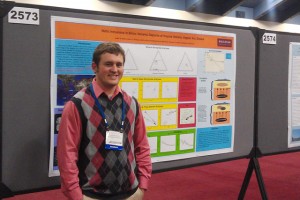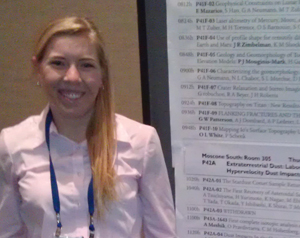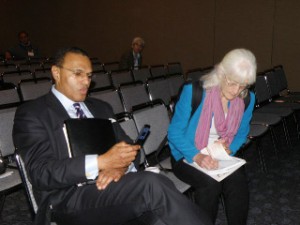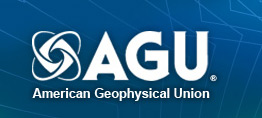Faculty, Students Present at International AGU Conference

Three faculty members from Earth and Environmental Sciences, as well as two graduate students and two undergraduate students, presented their research at the annual conference of the American Geophysical Union (AGU) in San Francisco, Calif., Dec. 5-7. The conference drew more than 20,000 scientists and policy makers from around the world.
Associate Professors Suzanne O’Connell and Dana Royer, Assistant Professor Phillip Resor, and Austin Reed MA-candidate, Rosemary Ostfeld BA ‘10/MA ‘12, and Julia Mulhern ’12 all attended. In addition, a poster by Katherine Shervais ’13, was also presented.
“Our research in the Department of Earth and Environmental Sciences is so diverse, and it is exciting to see Wesleyan faculty, students, and alumni contributing to technical sessions spread across many of the AGU sections,” Resor says.

O’Connell began her presentations on the day before the conference officially opened with a pre-conference workshop for department heads and chairs titled “Advancing Women and Underrepresented Minorities in the Academic Geosciences,” which she co-organized with Mary Anne Holmes, associate professor, University of Nebraska-Lincoln.
O’Connell and Holmes also presented “Increasing Diversity in the GeoScience Workforce I & II, and “Writing Retreat Increases Productivity and Community for Women Geoscientists.” She and graduate student Rosemary Ostfeld BA ’10, MA ’12 presented a poster titled “Bedform formation in the Glastonbury meanders of the Connecticut River.” O’Connell also led a session titled “This Diversity Initiative Will Work.”
Royer convened a session titled: “Earth System Sensitivity to Radiative Forcings: Lessons From Earth History,” which discussed, among other things, “climate sensitivity” – a concept that examines how much warming occurs on the Earth with a given change in CO2. He also gave two invited talks: “Geological constraints on Earth system sensitivity to CO2 during glacial and non-glacial times,” which discussed how geologic records from the last 140 million years can place constraints on climate sensitivity; and “Convergent Cenozoic CO2 history,” which examined atmospheric CO2 patterns over the last 65 million years.
Resor presented a poster in a session titled “What Can Fault Rocks Tell Us About Earthquake Mechanics?” This provided a first look inside an ancient earthquake-producing fault using high resolution x-ray computed tomography. The images revealed clear evidence that frictional melting was occurring on portions of the fault where the friction was high while low friction areas were not melting. These are preliminary results from a study that will extend over the next two years in collaboration with Resor’s colleagues at the Istituto Nazionale di Geofisica e Vulcanologia (Rome) and University of Akron.

Graduate student Austin Reed gave a poster presentation titled “Mafic Inclusions in Silicic Volcanic Deposits of Nisyros Volcano, Aegean Arc, Greece” which detailed his use of a variety of analytical techniques to decipher the complex relationship between the silicic hosts and their mafic counterparts within the four most recent eruptions. Reed is advised by Johan Varekamp, the Harold T. Stearns Professor of Earth and Environmental Sciences.
Julia Mulhern ’12 gave a talk in a session titled “Using Topography to Investigate the Evolution of Solar System Bodies.” Mulhern examined what can be inferred about the mechanisms of crustal deformation by analyzing the geometry of folds on these surfaces. Her work showed that differentiations can be found between two end-member folding processes: buckling and forced folding over faults, and that both processes appear to shape the surface of Venus. Mulhern is advised by Resor and Martha Gilmore, associate professor of Earth and Environmental sciences.

The poster by Shervais ’13 was titled “Integrated Field Analyses of Thermal Springs: UT, ID, CA,” and based on studies she and other students did in the summer of 2011 using new technology such as the iPad 2 and devices they designed themselves to update and streamline the process of geothermal exploration. She received funding for this study from Southern California Earthquake Center and the Utah Geological Survey.
The Wesleyan contingent also enjoyed a dinner during the conference with Wesleyan alumni Jessica Pfund ’05, Intan Suci Nurhati ’05, Rebecca Sorell ’08, Max Gardner ’10, Gus Seixas ’10, and Satrio Wicaksono ’10.

